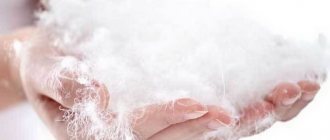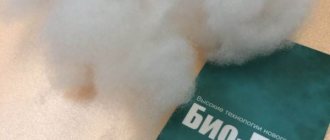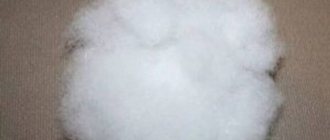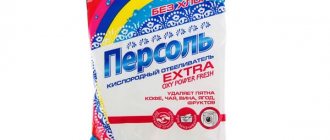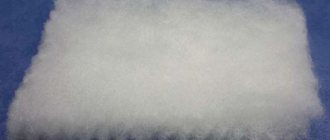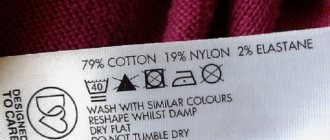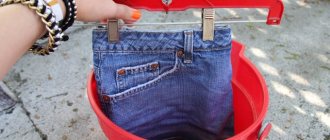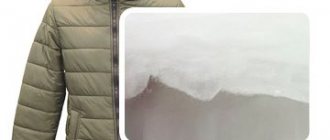This material is a domestically produced heat insulator and is designed for use in professional fields of human activity. The creation of the fabric is based on a special principle of connecting fibers, which involves the use of polyester microfibers.
In this article we will reveal several secrets and tell you what Shelter insulation is, we will turn to the main features of the texture, we will analyze the advantages and disadvantages, we will highlight the criteria for choosing clothes from it, and we will also tell you where it is used.
Production Features
Non-woven synthetic insulation is the result of research and extensive work by Russian chemists. In the production of textiles they use a special fiber – “Organic Fiber”, which is several times thinner than human hair.
How is dense filler made? Craftsmen make it using hot air. High temperatures help bond the material without the use of various harmful chemicals. This production method is environmentally friendly for nature and harmless to humans.
This technology used by scientists is called 4D. Thanks to this method, the fabric retains all its qualities for a long time and is maximally resistant to elastic deformation. Shelter insulation is used in construction (for various surfaces) and in textiles (for warm winter clothes).
For the first and second cases, there are a huge number of varieties, slightly different from each other in their indicators. For example, for the clothing industry - it is the most durable, reliable and warm.
Comparison with analogues
The main competitors of the material in terms of thermal insulation properties are traditional insulation materials “swan's down” and modern synthetic analogues Tinsulate® and Holofiber®. Compared to batting, in terms of basic properties, shelter is approximately 2 times superior to this material. Comparisons with padding polyester and other cheap synthetic analogues are incorrect due to the high clumping properties of padding polyester and insufficient compliance with environmental standards (use of glue in manufacturing).
Main technical characteristics
Now let's take a closer look at the properties of the material. They vary slightly depending on the application, but the average values remain the same.
Let's look at the main indicators:
- The canvas can be used for a long time.
Thanks to the manufacturing technology, it is durable: the jacket will last you for several decades, and the construction raw materials will last for almost a century.
- Environmentally safe and does not pose a threat to health.
This is very important, since children can also come into contact with shelter insulation for clothing. Harmful chemical vapors from other tissues harm the general condition of the child and cause allergic reactions. Even during production it does not generate dust.
- Resistant to rodents, moths and moisture.
Most small pests do not favor polyester fibers, and therefore mice or moths will not get into your overalls. You can also be calm about mold: moisture is not retained, and the greenhouse effect does not occur.
- Does not oxidize and does not react with chemical reagents.
The fabric is resistant to many alkalis and acids. The material can be easily washed using regular powder.
- Belongs to the group of non-flammable fabrics.
Shelter clothing insulation is practically incapable of burning. It also has another important property: when exposed to fire, the fiber simply melts without emitting harmful substances into the atmosphere, including large amounts of acrid smoke.
- It varies in density depending on the type and purpose.
For clothing, lighter weight fabrics are used, for construction - maximum weight and density.
- Lets out steam.
Vapor permeability helps combat overheating and damage to walls when used as cladding. The filler helps maintain a favorable temperature in the room and under a warm jacket.
- Does not absorb moisture.
The canvas has virtually no tendency to get wet due to the materials used in production. Even if water gets on the fabric, it will not change its properties.
- Retains heat well.
The thermal conductivity coefficient of the insulation is quite low, and therefore you will be warm in a sheathed room or in a brand new jacket.
Recommendations for product care
In order to ensure long-term use of clothing, you must follow these simple rules:
- Smoothing using steam is not allowed.
- Before use, it is necessary to keep the material for 24 hours at room conditions.
- Washing in an automatic washing machine is allowed, subject to a gentle cycle.
Thus, as a rule, buyers do not have any problems with care.
How to wash in a washing machine
To maintain its thermal insulation qualities, you should pay attention to the markings on the fabric for washing; it must be washed under the following conditions:
- delicate wash cycle;
- no spin.
If possible, Shelter should be taken to professional establishments for special cleaning.
It is best to hang the material so that the water drains quickly. Non-contact steaming is also allowed.
Advantages of insulation
Shelter has a number of advantages over other thermal insulation fabrics.
The advantages include:
- Versatility of use.
A wide range of products helps you choose the option you need for textiles or construction.
- Eco-friendly and hypoallergenic.
This fiber is easily used when sewing children's clothing. They are also advised to insulate even such environmentally friendly buildings as wooden houses. All this is possible due to the fact that no harmful glue is used in production.
- Protection from getting wet.
Polyester does not retain moisture, and therefore the fiber almost always remains dry.
- Retains heat even with the smallest thickness.
The thickness of the filler starts from 50 mm. This indicator also indicates the thermal conductivity of the fabric.
Shelter® Profi AS
Shelter® Profi AS insulation is designed to insulate the clothing of employees working in environments where the presence of static electricity is unacceptable. Special metallized fiber significantly increases the antistatic properties of the insulation compared to conventional insulation, thereby reducing the likelihood of spark formation and its power. This property allows the material to be used in workwear for work in conditions of increased explosion hazard and flammability.
The antistatic effect is achieved by a special insulation composition, where, along with synthetic fibers, special metallized fibers are added, along which static electricity “flows”. The insulation has no analogues in Russia. Part of the new line of Shelter® Profi clothing insulation.
Special Property:
· Antistatic effect: does not accumulate static electricity
Retains thermal insulation properties when wet. Individual fibers absorb less than 1% water by weight. Dries quickly.
The main disadvantages of Shelter insulation for clothing
If you decide to opt for equipment made from this material, then you should take into account some of the disadvantages.
These include:
- Passing steam, but not in large quantities.
Vapor permeability is still weaker than most organic fibers.
- The price of the original canvas is quite high.
This also affects the cost of things made from it. The cost is offset by quality and other benefits.
Reviews
Reviews about shelter insulation will reinforce your faith in the unique qualities of the material - we have collected several reliable comments from those who have managed to evaluate the advantages in practice.
1.Shelter kids insulation perfectly protects from wind and cold, does not require maintenance - ideal qualities for a winter jacket. The child walks for two seasons until the performance qualities are lost!
2. We bought two jackets - for me and my husband, so that we could walk in winter and not be afraid of the cold. I can say that the products are as comfortable as possible, retain heat well, but do not create a greenhouse effect and remove excess moisture. Although the price of shelter soft insulation is a bit steep, it is worth it.
3. Really high-quality material - I am familiar with it from the workwear of my husband, who worked in northern latitudes. In such a suit you can spend half a day outside without freezing!
You have studied reviews of shelter insulation for clothing, wearing temperature, and main characteristics. This is a strong, durable fiber that reliably protects from the cold, meets the highest quality requirements and can be used by both children for everyday wear and adults working in extreme conditions. See here the sizes of underwear for women correspondence table.
Criterias of choice
During construction:
- The exclusive right to create this filler belongs to only one.
- The manufacturer notes that the color should vary from white to beige. This shade continues in the future.
When choosing sports equipment, remember that the clothing should be:
- Warm. It’s good if the jacket or sports trousers have leg warmers that keep the cold out, fur trim or a spacious hood.
- Convenient. Try on the item and walk around in it, try to sit down, bend over, make sure that nothing is pressing or restricting movement.
- Quite dense. The fabric should not be see-through. In a high-quality fabric, the threads fit tightly together.
- The label must indicate the percentage of shelter content. The optimal value is 100%.
Shelter® Profi FR
Shelter® Profi FR is thermally bonded fire-resistant insulation made from staple fiber in Russia The special protective properties of Shelter® Profi FR allow it to be used in special clothing intended for conditions involving the risk of short-term contact with an open flame or exposure to an electric arc.
Special Property:
Fire resistance: does not spread fire and does not melt
The properties of Shelter® Profi FR insulation are confirmed by test results at the Central Research Institute of the Garment Industry*.
| Fire resistance (time of contact with flame 10 s) | After exposure to flame |
| Residual combustion, s | Absent |
| Residual smoldering, s | Absent |
| The fire does not spread to the edges of the sample. No through holes are formed. The material does not support combustion. | |
Confirmed by Test Report of JSC TsNIISHP No. 374 dated August 19, 2013.
Where can I buy
ManufacturerMoscowKazan
Factory of Nonwoven Materials "Whole World" Official website: https://www.wesmir.com/ Tel.,
Shop "Season" on Avtozavodskaya Opening hours: from 10.00 to 21.00 without days off and lunch breaks Store address: Moscow, st. Avtozavodskaya, 9/1 metro station "Avtozavodskaya" Tel
Season store in Kazan Opening hours: from 10.00 to 21.00 Store address: Kazan, st. Yamasheva, 93 (TD "Savinovo"), 3rd floor. Tel. (atelier) (843) 517-07-55
© 2022 textiletrend.ru
Material properties
The basis of the material is polyester microfibers . Thanks to the exceptionally fine texture of the fibers, the insulation retains its properties with a minimum volume.
The material is exceptionally soft and elastic. The absence of fiber migration ensures the strength and durability of the material. The insulation can withstand washing in various conditions, does not shrink, and the volume is restored unchanged . Shelter as insulation for clothing is breathable and breathable.
TechnoNIKOL is a reliable Russian brand
This is an exclusively Russian brand that has 53 factories in 7 countries. Among them are Germany and Great Britain, Italy and Lithuania. Official representative offices are located in 18 countries. The company's training centers are also located there. TechnoNIKOL has its own Research Centers for the development of new technologies for heat and sound insulation. The products of this concern are very popular due to competitive prices and are sold in 95 countries.
TechnoNIKOL general building thermal insulation based on stone wool
An inexpensive way to perform thermal insulation on any construction site is with materials based on stone wool with a universal purpose. At TechnoNIKOL such products are represented by the BAZALIT series. All brands can be mounted horizontally or vertically.
- BAZALIT L-30 - has a density of 25-35 kg/m3 and a thermal conductivity of 0.032 W/(m*K) at an outside temperature of 10 degrees. Well suited for a base layer followed by cover.
- BASALIT L-50 - denser slabs (36-50 kg/m3), designed for installation in any spatial position. Particularly good for the bottom layer when insulating floors and interfloor ceilings.
- BASALIT L-75 is the most dense material based on stone wool with an indicator of 51-75 kg/m3. Vapor permeability of 0.5 mg/(m.h.Pa) allows its use in the middle layer on walls with light masonry.
TechnoNIKOL stone wool for insulation of all types of roofs
For all types of roofing, the TechnoNIKOL company has developed a line of TECHNORUF insulation materials. The TECHNORUF N EXTRA brand is produced in the form of a basalt slab with a density of 90-110 kg/m3 and can withstand pressure up to 3000 kg per 1 m2. It is optimal for arranging a sloping roof. TECHNORUF N PROF is next in class and has a density of 110-130 kg/m3. With a deformation of 10%, it is capable of carrying a load of up to 4000 kg per square meter, which is also not bad for insulating a roof of complex shape.
TECHNORUF V PROF is designed for all types of flat roofs. It has a pronounced hydrophobic effect. It can act as the top durable layer in three-layer structures. Its density is 175-205 kg/m3, and its strength can withstand up to 8000 kg of pressure per m2. To quickly create a slope on a flat roof for precipitation, use TECHNOROOF WEDGE 4.2%, which automatically forms a slope contour. At the same time, cotton wool itself effectively combats cold retention and has a thermal conductivity index of 0.038 W/(m*K).
TechnoNIKOL TECHNORUF N EXTRA.
TechnoNIKOL stone wool for insulation of ventilated facades
For ventilated facades, the manufacturer offers a whole line of basalt wool from the TECHNOVENT series. TECHNOVENT EXTRA brand is quite suitable as a base layer or in combination with another insulator. Its breathability is 35 m*s*Pa.
There is another type of this material - this is TECHNOVENT N PROF, the air permeability of which is 80 m*s*Pa. The insulation is intended for use in industrial and civil construction during new construction and reconstruction of buildings and structures for various purposes as an inner layer with two-layer thermal insulation in curtain wall systems with an air gap.
TechnoNIKOL stone wool for insulating a wet facade
TECHNOFAS EXTRA insulation, designed to retain a thick layer of plaster, is well suited for wet facades. The density of the slab is 80-100 kg/m3, and the thickness is from 50 to 150 mm.
When a thin layer of plaster is planned, you can save money and choose TECHNOFAS EFFECT, which, with a smaller cross-section, has an increased density of 125-137 kg/m3, which will provide the required strength. TECHNOFAS DECOR is produced for insulating facades on balconies and loggias, therefore it has an increased tensile strength of 25 kPa.
TechnoNIKOL TECHNOFAS EXTRA.
TechnoNIKOL stone wool for use in frame buildings
Frame buildings have a dilemma: the insulation must be dense enough so as not to sag over time, and at the same time not heavy so as not to overload the structure. For this purpose, the TECHNOBLOCK series is best suited, which is designed for installation in frame walls and subsequent cladding. The STANDARD brand has a density of 40-50 kg/m3, and PROF 60-70 kg/m3. The thickness of the slabs ranges from 50 to 150 mm and they are suitable for any walls of a frame house.
In order not to burden the structure with massive insulation in the partitions inside the frame house, the manufacturer produces a lightweight version - the TECHNOLITE line. It has three types (EXTRA, OPTIMA, PROF) and density from 30 to 46 kg/m3. The thickness varies from 50 to 200 mm, which is suitable for any type of partition.
TechnoNIKOL TECHNOBLOCK.
Important consumer benefits
- Winter clothing based on shelter filler turns out to be almost weightless, since the insulation itself is incredibly light, and the clothing does not restrict movement. But at the same time, the material retains heat well. The microfibers that are part of it provide maximum thermal protection. It is also very comfortable to wear.
- Shelter brand clothing filling has an excellent heat transfer system. Even under intense exercise, your body will always breathe.
- It is safe for health, an environmentally friendly product does not cause allergies - proven by certificates.
- After washing, the insulation does not lose its qualities, including its appearance, and also dries very quickly. So you don’t have to be afraid to wash your favorite down jacket in fear that the shelter filler won’t hold up.
Varieties
Having versatile modifications, the shelter allows you to create workwear for different fields of activity . The main types of heat-saving shelter filler:
- Shelter Profi ST - heat preservation in low temperatures.
- Shelter Profi AS - protection against the formation of static electricity.
- Shelter Profi FRAS - high antistatic properties and fire resistance.
- Shelter Profi FR - material immunity to short-term exposure to flame and welding arc.
Fire-resistant and heat-insulating insulation consists of 100% polyester , in contrast to insulation with antistatic properties, which includes an additional reinforcing component - metallized fibers. The density of the material varies from 60 to 200 g/m2 depending on the purpose of the product.
Alternative uses
Effectively retaining heat, shelter is successfully used for the production of casual outerwear for adults and children .
The material is in demand for creating equipment for organizing northern expeditions in extremely low temperature conditions, as well as for field conditions for representatives of law enforcement agencies - the Ministry of Defense and the Ministry of Internal Affairs.
In construction, thermal protection material is a universal insulation material for buildings, structures, interfloor ceilings, facades, roofs, and attics.
For thermal insulation, polyester boards are used, simplifying the installation process for large volumes.
The Shelter Loft line is used to produce sleeping bags, and Shelter Home - mattress covers and blankets.
Application in sewing workwear
High-quality insulation works for the benefit of the enterprise: employees are provided with health protection , while insufficient protection from frost can cause frequent colds in the team, undermining the production process.
Maintaining a constant temperature in outerwear is necessary:
- military;
- installers;
- firefighters;
- security guards;
- utility workers;
- workers of the North.
The number of specialists interested in good insulation is not limited to the indicated list.
All workers forced to serve in unfavorable natural conditions require protection from the cold . Shelter is universal: it is used for different types of workwear, from work suits with insulated trousers to hats and overalls.
The condition of the new winter airborne uniform has been tested not only for quality, but also for time: tested at low temperatures and exposed to piercing winds.
You should choose winter mittens carefully. Read how to do it right here.
